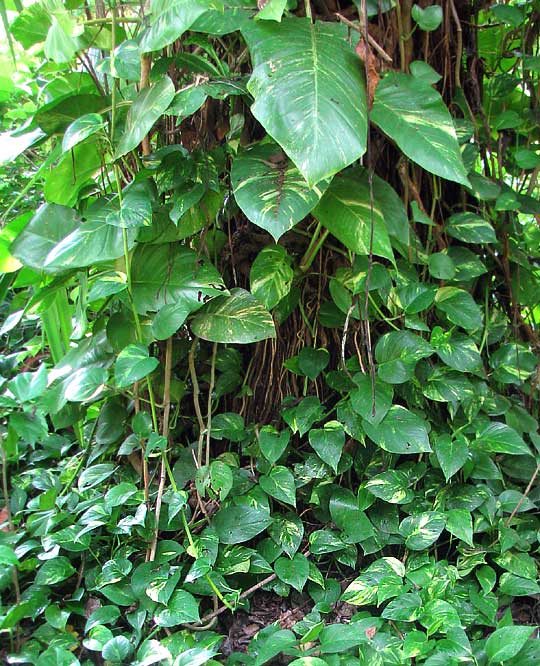Excerpts from Jim Conrad's
Naturalist Newsletter

from the December 20, 2009 Newsletter issued from Hacienda Chichen Resort beside Chichén Itzá Ruins, central Yucatán, MÉXICO; limestone bedrock, elevation ~39m (~128ft), ~N20.676°, ~W88.569°
POTHOS VINE
Maybe at Hacienda Chichen the ornamental plant most asked about by visitors is the Pothos, EPIPREMNUM AUREUM. It's closely related to the Philodendrons, thus a member of the Aroid Family, the Araceae. You can see one wrapping itself around a Royal Palm trunk above.
Pothos, native to Southeastern Asia, impresses people with its sheer robustness, climbing up trunks 65 feet (20 m) and producing broad, glossy, yard-long (meter-long) leaves on shovel-handle-thick stems using aerial roots to climb. You can see stems and petioles below:

Pothos does something interesting: When it grows tall it starts sending down leafy stems a little like the things Tarzan swings on in the movies. When the stems reach ground they root and start wandering on the ground horizontally, and can eventually form a very attractive, closed groundcover. The wandering stems bear leaves much smaller than those on climbing stems. If you whack off a stem section and pot it, you'll get a very attractive plant of manageable size. You can see the base of a tree trunk overgrown with Pothos, with large leaves above and small ones on the ground, below.

Noticing the leaves' yellow streaks, you may think you recognize Pothos as a potted plant in your own home or at least in your hometown shopping mall lobby, and you're probably right. Pothos is one of the North's most common houseplants. On the one hand, studies show that Pothos removes indoor pollutants such as formaldehyde, xylene, and benzene; on the other hand, the plant may be toxic to dogs and cats due to insoluble calcium oxalates in its herbage.
You might notice that the big high leaves in the first picture had many splits in their blades while the last two pictures showed leaves with few to no splits. Basically young, lower leaves tend to be splitless while higher or older leaves have lots of splits.